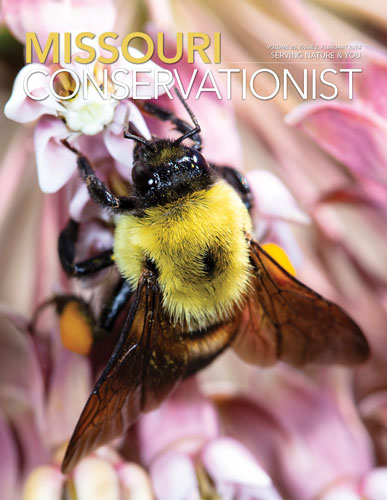Got a question for Ask MDC? Send it to AskMDC@mdc.mo.gov or call 573-522-4115, ext. 3848.
Q: I’ve been seeing this cardinal throughout the year. I assumed it was an immature cardinal that would eventually change colors; however, after months of seeing this bird, it hasn’t. Will this be his permanent color? Is there a name for a cardinal with this coloration?
This is an adult male northern cardinal, but it lacks the mask of typical black pigment, or “eumelanins,” on his face. A common form of melanin, eumelanins are brownish to black pigments that protect the epidermis — the outermost layers of skin — against damage from ultraviolet radiation. Ornithologists might say this bird lacks eumelanin in part of its body or is partially “non-eumelanic.”
This is probably a rare genetic abnormality.
Q: Does Missouri have a body of water known to have a good chain pickerel population? I fish on Lake of the Ozarks several times a year. A side trip to complete my pike slam would be great!
A favorite target for anglers, chain pickerel are not widespread in Missouri, so MDC Fisheries Management Biologist Scott Williams recommends focusing your search to the southeastern Ozarks from the Eleven Point River east to the St. Francis River.
“Reportedly, its greatest abundance is in the Eleven Point and Current rivers,” Williams said. “I would focus on slow deep pools and backwaters that have abundant aquatic vegetation to try to find chain pickerel.”
This game fish has an elongated body, a snout shaped like a duck’s bill, and a large mouth with many sharp teeth. The back and sides are olive or yellowish brown with a chainlike pattern of dark lines. The dorsal fin is positioned far back on the body.
They inhabit clear, quiet waters where aquatic vegetation is abundant, particularly in backwater sloughs of streams. Adult chain pickerel lie motionless in dense stands of vegetation and ambush prey with a quick darting motion. Young chain pickerel feed on crustaceans and aquatic insects. Adults are carnivorous and feed on other fishes.
Chain pickerel, grass pickerel, and pike resemble one another but are different species of fish. (Grass pickerel are quite like chain pickerel but more widespread.) All three species can be found in freshwater, but pike are much larger. For more information on chain pickerel, visit short.mdc.mo.gov/Zjy.
Q: I took pictures of this deer coming to our corn feeder, and I noticed it had a swollen jaw. What do you think is the cause?
It appears you are seeing a deer afflicted with a disease informally called “lumpy jaw.” Regrettably, it’s somewhat common in Missouri, although MDC scientists cannot tell you precisely how many deer have the disease annually in our state.
Unfortunately, this occurs when a food impaction is created by arterial worms. Partial paralysis of the deer’s jaw muscles occurs when high arterial worm infestations reduce blood flow. Subsequent infections can result in food being impacted under the tongue, causing facial swelling, occasional tooth loss, and jawbone degeneration. The nematodes, or worms, live in the carotid arteries of white-tailed deer, and deer contract them when bitten by infected horseflies.
These worms pose no threat to humans, and the venison of infected deer is safe for consumption. For more information about this disease, visit short.mdc.mo.gov/Zj9.
And More...
This Issue's Staff
Editor - Angie Daly Morfeld
Associate Editor - Larry Archer
Photography Editor - Cliff White
Staff Writer - Kristie Hilgedick
Staff Writer - Joe Jerek
Staff Writer – Dianne Van Dien
Designer - Shawn Carey
Designer - Marci Porter
Photographer - Noppadol Paothong
Photographer - David Stonner
Circulation – Marcia Hale






















